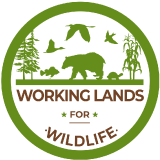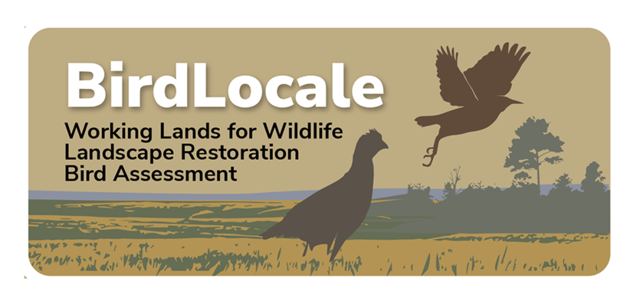-
Deerfield watershed Stream Crossings Explorer
-
by
Tab Manager
—
published
Apr 10, 2024
—
last modified
Apr 21, 2025 06:28 PM
—
filed under:
Maps,
WLFW
This tool helps you locate road-stream crossings based on your interests.
Located in
Learning & Tech Transfer
/
Apps, Maps, & Data
-
Defenders of Wildlife Private Lands Conservation
-
by
Tab Manager
—
published
Feb 18, 2023
—
last modified
May 29, 2025 05:58 PM
—
filed under:
Landowner Resources,
WLFW,
Defenders of Wildlife,
Landowner Information,
Working Lands for Wildlife,
Resources
Defenders works with private landowners, land trusts and other partners to communicate, educate and apply conservation and restoration techniques on the ground habitat to advance species recovery and wildlife coexistence on private lands nationwide.
Located in
Landowner Information
/
Landowner Resources
-
 Do Review Papers on Bird–Vegetation Relationships Provide Actionable Information to Forest Managers in the Eastern United States?
Do Review Papers on Bird–Vegetation Relationships Provide Actionable Information to Forest Managers in the Eastern United States?
-
by
Tab Manager
—
published
Mar 29, 2022
—
filed under:
Forestry,
Literature Gateway,
Resources,
silviculture
Herein, we focus on a common problem of the science–practice interface in the context of forest wildlife habitat management. That is, are wildlife scientists providing information that is both relevant and specific enough to be actionable in real-world, evidence-based forest management contexts?
Located in
Resources
-
Do Review Papers on Bird–Vegetation Relationships Provide Actionable Information to Forest Managers in the Eastern United States?-Additional Information
-
by
Tab Manager
—
published
Mar 29, 2022
—
filed under:
Literature Gateway
Herein, we focus on a common problem of the science–practice interface in the context of forest wildlife habitat management. That is, are wildlife scientists providing information that is both relevant and specific enough to be actionable in real-world, evidence-based forest management contexts?
Located in
Resources
-
Eastern Deciduous Forest Health
-
by
Tab Manager
—
published
Dec 30, 2020
—
last modified
Jul 15, 2025 12:01 PM
Forest management affects wildlife habitat by altering the structure and composition of vegetation communities. Every wildlife species uses a specific set of resources associated with different species and ages of forest trees (e.g., nesting cavities, den sites, acorn crops, fruit resources) to survive and reproduce. Forest managers, wildlife conservation groups, policy makers, and other stakeholders often need to review the literature on forest bird-vegetation relationships to inform decisions on natural resource management or ecosystem restoration.
Located in
Issues
-
Eastern Deciduous Forests
-
by
Tab Manager
—
published
Dec 06, 2024
—
last modified
Jul 15, 2025 05:00 PM
In the northeastern U.S., partners are helping reinvigorate private forestry as a viable—and sustainable—industry. After decades of harvesting valuable trees from forests and leaving the rest, eastern deciduous forests are a monoculture of same-age or same-species trees, lacking both market value and healthy wildlife populations. WLFW “hit the reset button” by working with forest owners to establish young forest stands and restore economic value and abundant wildlife such as white tailed deer, turkey, ruffed grouse, and rarer species like the golden-winged warbler.
Located in
Landscapes
-
Eastern Deciduous Forests
-
by
Tab Manager
—
published
Dec 06, 2024
—
last modified
Jul 15, 2025 05:41 PM
In the northeastern U.S., partners are helping reinvigorate private forestry as a viable—and sustainable—industry. After decades of harvesting valuable trees from forests and leaving the rest, eastern deciduous forests are a monoculture of same-age or same-species trees, lacking both market value and healthy wildlife populations. WLFW “hit the reset button” by working with forest owners to establish young forest stands and restore economic value and abundant wildlife such as white tailed deer, turkey, ruffed grouse, and rarer species like the golden-winged warbler.
Located in
Landscapes
-
Eastern Deciduous Forests
-
by
Tab Manager
—
published
Dec 06, 2024
—
last modified
Jul 15, 2025 05:42 PM
In the northeastern U.S., partners are helping reinvigorate private forestry as a viable—and sustainable—industry. After decades of harvesting valuable trees from forests and leaving the rest, eastern deciduous forests are a monoculture of same-age or same-species trees, lacking both market value and healthy wildlife populations. WLFW “hit the reset button” by working with forest owners to establish young forest stands and restore economic value and abundant wildlife such as white tailed deer, turkey, ruffed grouse, and rarer species like the golden-winged warbler.
Located in
Landscapes
-
Eastern Deciduous Forests
-
by
Tab Manager
—
published
Dec 06, 2024
—
last modified
Jul 15, 2025 06:03 PM
In the northeastern U.S., partners are helping reinvigorate private forestry as a viable—and sustainable—industry. After decades of harvesting valuable trees from forests and leaving the rest, eastern deciduous forests are a monoculture of same-age or same-species trees, lacking both market value and healthy wildlife populations. WLFW “hit the reset button” by working with forest owners to establish young forest stands and restore economic value and abundant wildlife such as white tailed deer, turkey, ruffed grouse, and rarer species like the golden-winged warbler.
Located in
Landscapes
-
Eastern Deciduous Forests
-
by
Tab Manager
—
published
Dec 06, 2024
—
last modified
Jul 15, 2025 06:18 PM
In the northeastern U.S., partners are helping reinvigorate private forestry as a viable—and sustainable—industry. After decades of harvesting valuable trees from forests and leaving the rest, eastern deciduous forests are a monoculture of same-age or same-species trees, lacking both market value and healthy wildlife populations. WLFW “hit the reset button” by working with forest owners to establish young forest stands and restore economic value and abundant wildlife such as white tailed deer, turkey, ruffed grouse, and rarer species like the golden-winged warbler.
Located in
Landscapes

